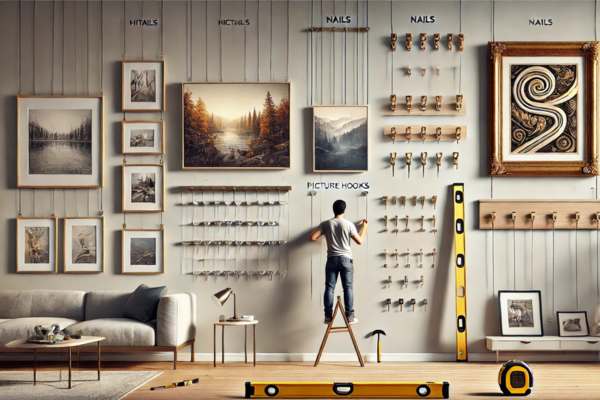Hanging art on the wall is a simple yet effective way to enhance your home’s aesthetic. Whether you’re decorating your living room, bedroom, or hallway, knowing how to hang art on the wall correctly can make all the difference. Proper placement ensures that your artwork not only looks great but also contributes to the overall balance of your space. In this guide, we’ll share expert tips and step-by-step instructions on how to hang art on the wall, from choosing the right frame to finding the perfect height. Get ready to transform your walls and showcase your personal style!
Choosing The Right Art For Your Wall

The journey begins with selecting the artwork that resonates with you. This is where the magic starts. The art you choose should mirror the tone and aesthetic of your space—whether it’s a bold abstract, a timeless landscape, or a vintage portrait. The key is balance. A small piece of art on a vast, empty wall risks getting swallowed, while an enormous canvas could easily dominate a smaller room. Size matters, but so does scale. Is your space modern and sleek, or warm and cozy? The right piece will tie everything together. But don’t just think of color and theme. Consider texture, style, and the atmosphere you wish to evoke. It’s the nuanced details that will bring your room to life.
Preparing To Hang Art On Your Wall

Preparation is half the battle won. Rushing into the hanging process can lead to disastrous results—crooked frames, holes in the wrong places, or worse, a display that doesn’t feel cohesive. Start by assessing the wall. Measure its height and width, and visualize how the artwork will interact with the furniture and lighting. The dimensions of the piece you plan to hang should complement these factors. Mark your spots carefully where nails or hooks will go. Your objective: symmetry, balance, and a sense of equilibrium. These are the elements that create a professional-looking, curated arrangement.
Understanding Wall Types Drywall, Brick, And Plaster
Not all walls are created equal. Drywall, the most common, can often handle lightweight art with basic nails or picture hangers. However, heavier pieces demand more substantial anchors. Brick walls, with their rugged texture, call for specialty screws or masonry anchors. For plaster, a material often found in older homes, precision is key. It’s easy to create cracks or gouges if you don’t account for the delicate nature of plaster. Here, a stud finder is your best friend, helping you locate the studs beneath the surface. The wall type dictates the method and tools you’ll use, ensuring both security and stability for your artwork
Essential Tools For Hanging Art

Equipping yourself with the right tools is vital for a successful hanging process. Start with the basics: a tape measure, pencil, hammer, and level. A tape measure will help you measure the space to perfection, while a level ensures your hang art on wall stays straight and never tilts over time. Picture hanging hooks, nails, or screws (depending on your wall material) are the foundation of a solid installation. Don’t forget the wall anchors, especially when hanging heavier pieces, as they distribute the weight and prevent any unfortunate accidents. Armed with these tools, you’re ready to bring your art vision to life.
Ensuring Proper Lighting To Highlight Your Artwork

Once your art is in place, lighting can either make or break the display. Without the right lighting, even the most stunning piece may go unnoticed. Consider picture lights, which are specifically designed to highlight artwork, or track lighting that can be adjusted to focus on the right areas. Wall sconces can add a softer, ambient light, perfect for more intimate spaces. Be cautious of direct sunlight, as it can fade colors and damage delicate art over time. A well-placed light not only draws attention to the artwork but also enhances its colors and textures, creating an inviting atmosphere.
Deciding On The Perfect Placement

Where you hang your art matters almost as much as what you choose. Typically, art is best hung at eye level—roughly 57 to 60 inches from the floor. But this is a guideline, not a hard rule. The room’s height, the size of the piece, and surrounding furniture all influence this decision. If you’re hanging art above furniture, aim for about 6-8 inches above the top of the piece. A large, commanding painting above a sofa will add grandeur, while smaller pieces might work better in entryways or hallways. The goal is to create a visual flow, where your eye naturally follows the artwork and its surroundings.
Arranging Multiple Art Pieces On A Wall

When it comes to multiple pieces, arranging them thoughtfully can turn a chaotic display into a stunning visual narrative. There are several methods: grids create an orderly, symmetrical look, while an asymmetrical layout can feel more dynamic and casual. When hanging multiple pieces, ensure consistency in either frame style, color scheme, or subject matter to tie everything together. Equally important is the spacing. Too tight, and the pieces will appear crowded; too far apart, and they may lose the effect of a cohesive gallery. The beauty lies in balance—carefully placing each piece until it feels right.
Step-By-Step Guide To Hanging Art On The Wall
- Measure and Mark: Start by measuring the wall and marking the placement for your artwork. Take into account the dimensions of the piece and the surrounding furniture.
- Level It Out: Next, use a level to ensure that your art will hang straight. Even the most skilled decorators occasionally miss this step, leading to tilted frames.
- Install Your Hooks or Nails: For heavier art, wall anchors or screws are a must. For lighter pieces, a simple nail or picture hook may suffice. Make sure to install them securely.
- Hang Your Artsy: Finally, place the artwork on the hooks or nails, step back, and evaluate the positioning. Adjust if needed, ensuring everything is balanced and aligned.
Creating A Gallery Wall Tips For Layouts And Arrangements

A gallery wall is a captivating way to display multiple pieces, but it requires thoughtful curation. Start by laying out your art on the floor to explore different configurations. A central piece can act as the anchor for the other artwork, creating a focal point. Play with frame sizes, but ensure they don’t clash in style. Consistency in color palette can further unify the display. Once you have a layout you love, carefully transfer it to the wall, making sure the spacing between pieces remains even. A gallery wall should feel curated yet effortless, with each piece telling its own story while contributing to the larger composition.
Choosing The Right Hanging Method

The method you choose for hanging your art depends largely on its size and weight. For lightweight art, picture hangers or nails may suffice. But when it comes to heavier pieces, you’ll need stronger options, such as D-ring hangers, sawtooth hangers, or wire systems. These methods ensure that the artwork stays securely in place for the long haul. Don’t underestimate the importance of a sturdy hanging system—your artsy deserves to be well-supported.
Hanging Art On Different Wall Types
Each wall type has its own set of challenges. Drywall is straightforward, requiring nails or screws that go directly into the studs for optimal support. For brick walls, masonry anchors are essential to hold the weight of the artwork. Plaster, while beautiful, is fragile. Here, picture hangers specifically designed for plaster, or a good stud finder, will help you avoid cracking the surface. Each wall type requires a tailored approach to ensure that your artwork hangs securely and elegantly.
Choosing Proper Wall Anchors For Heavy Art

Heavy art deserves special consideration when it comes to anchors. Simple nails won’t do the trick for substantial pieces. Instead, toggle bolts, molly bolts, or other heavy-duty anchors will provide the necessary support. These types of anchors distribute the weight evenly, preventing the artsy from pulling away from the wall. Always check the weight rating on the anchor packaging, and never overestimate the capacity of your hardware.
Tips For Hanging Large Or Heavy Art Pieces
Hanging large or heavy art pieces requires extra care. Start by ensuring your wall can bear the load. Use a stud finder to locate the studs and anchor the piece directly into them for the best stability. For extra security, two hangers or hooks can help evenly distribute the weight across the piece. Be sure to use heavy-duty hanging wire if necessary, as flimsy cords could snap under pressure. The stability of your artsy is paramount, so double-check that everything is secured properly before stepping back to admire your work.
Adding Personal Touches To Your Art Display
Art is a deeply personal element of home design. To make your display truly unique, consider adding personal touches like custom frames, mats, or even decorative objects that complement your artwork. Mirrors, vintage plates, or sculptures can serve as delightful companions to your wall art, creating a dynamic, multi-dimensional display. Let your personality shine through the artsy you select and the way it’s framed, displayed, and highlighted.
Maintaining And Updating Your Art Display
An art display is a living thing. Over time, you may want to rearrange pieces or refresh the overall display. Keep your hang art on wall and frames clean by dusting with a microfiber cloth and cleaning glass with a non-abrasive cleaner. The right environment is key to preserving your artsy avoid hanging it in places with high humidity or direct sunlight, as both can cause irreversible damage. Consider framing your artwork with protective glass, especially if you live in a coastal area where humidity levels are higher.
Frequently Asked Questions
– How High Should Art Be Hung Above Furniture?
The general guideline is to hang artwork 6-8 inches above furniture, such as a sofa or console table. However, the exact distance will depend on the piece’s size and the height of theroom. The most important thing is to keep the artsy at eye level or slightly above, ensuring it remains the focal point of the room.
Final Thoughts
Knowing how to hang art on wall properly can transform your living space, creating a more polished and stylish atmosphere. By considering the right placement, tools, and strategies, you could acquire a balanced and pleasing display. Remember, the secret’s to choose a top that enhances the room’s layout and enhances the general design. With cautious making plans and attention to detail, placing artwork can grow to be a easy but powerful manner to customise your space.

